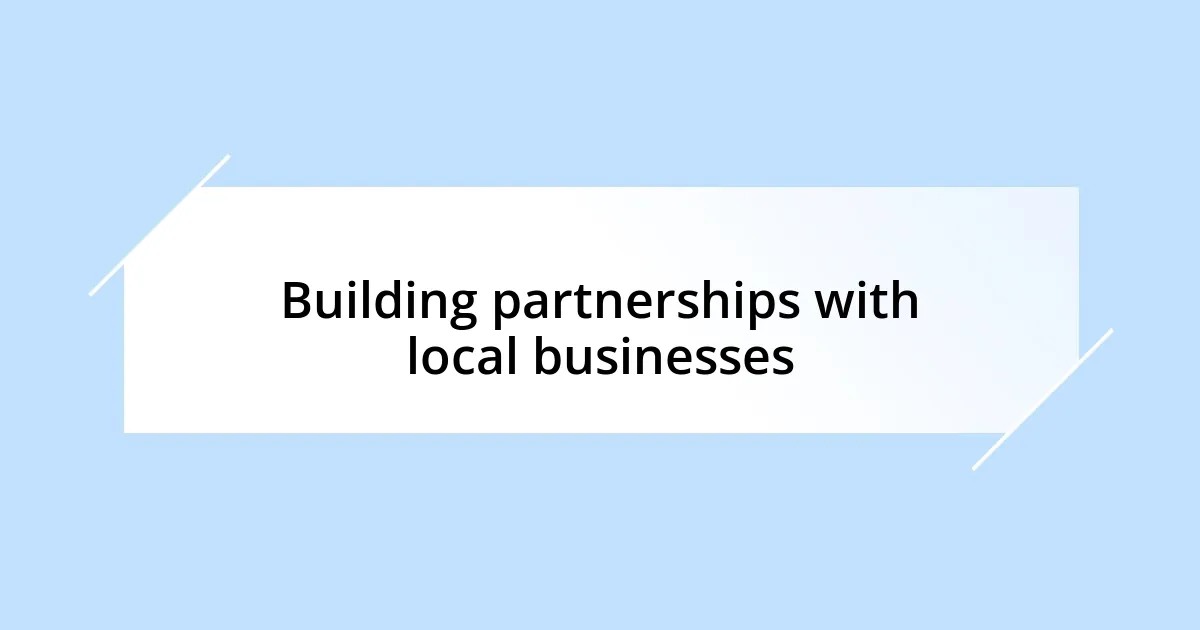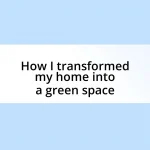Key takeaways:
- Recycling fosters community bonds and promotes sustainable practices, enhancing local engagement.
- Identifying common recyclable materials and making information accessible encourages active participation in recycling initiatives.
- Organizing community events, like fairs and workshops, creates excitement and offers educational opportunities around recycling efforts.
- Building partnerships with local businesses strengthens recycling initiatives and creates mutually beneficial programs to encourage sustainability.

Understanding the benefits of recycling
One of the most immediate benefits of recycling that I’ve experienced is the sense of community it fosters. When I started a local recycling group, I noticed how people were eager to come together and share their experiences. The simple act of sorting materials sparked conversations about other sustainable practices, creating bonds that went beyond just recycling.
Recycling not only conserves natural resources, but it also reduces pollution—a fact that hits home for me every time I see a clean park versus one littered with waste. It’s heart-wrenching to think how our choices impact our surroundings. Can you imagine walking in a place where nature thrives, instead of dodging plastic bottles and wrappers? That vision fuels my commitment to making recycling a community norm.
Moreover, engaging in recycling can have substantial economic benefits. I remember attending a local council meeting where a representative explained how recycling generates jobs and stimulates the local economy. Isn’t that an encouraging thought? Knowing that our eco-friendly actions can create opportunities for others feels empowering and is yet another reason to champion recycling efforts.

Identifying common recycling materials
Identifying common recycling materials is crucial for effective community engagement. In my experience, starting with the basics—like paper, plastic, glass, and metals—can create a shared understanding among community members. For instance, when I led a workshop on recycling, I provided examples of common household items like cereal boxes and aluminum cans. Seeing familiar items really resonated with attendees, making them more likely to participate actively in recycling initiatives.
It’s fascinating to note that many people still struggle with identifying recyclable materials. I remember chatting with a neighbor who was unsure if certain plastics were recyclable, so I brought over a simple guide showing the recycling symbols and their meanings. That little effort transformed their approach to waste management—it’s all about making information accessible and relatable!
To help visualize this better, I’ve put together a comparison table of common recyclable materials. This not only consolidates what I’ve shared but serves as a handy reference for community members looking to get involved.
| Material | Recycling Notes |
|---|---|
| Paper | Clean and dry, remove plastic windows from envelopes. |
| Plastic | Check the recycling symbol; #1 and #2 are commonly accepted. |
| Glass | Rinse before recycling; colored glass is also recyclable. |
| Metals | Clean aluminum and tin cans are widely accepted. |

Creating a local recycling program
Creating a local recycling program starts with involving the community from the ground up. When I first approached my neighbors about setting one up, I noticed their excitement. Gathering feedback through casual conversations made me realize the diverse needs we had. For example, a local artist expressed a desire for a space to reclaim materials for their projects. It’s incredible how identifying individual passions can add layers to a recycling initiative, transforming it into a vibrant hub of creativity and cooperation.
Here’s how I structured our local recycling program:
- Community Engagement: Host informal meet-ups to discuss recycling goals and gather input.
- Educational Workshops: Organize events that focus on creative reuse of materials, such as art projects or DIY home items.
- Strategic Partnerships: Connect with local businesses and schools to expand outreach and resource sharing.
- Regular Collection Drives: Schedule monthly events to gather recyclables from households, ensuring visibility and consistent participation.
- Feedback Loop: Provide a platform for community members to share their experiences and suggest improvements continuously.
By fostering a sense of ownership, everyone involved feels more connected and motivated. It’s the little victories—like seeing a neighbor proudly display their repurposed materials—that remind me why I started this journey. Embracing recycling as a community effort not only reduces waste but also nurtures friendships and shared values.

Promoting recycling through events
One effective way I’ve found to promote recycling in my community is by organizing engaging events that bring people together. Last year, I spearheaded a “Recycling Fair” in our local park, where families could learn about recycling while enjoying a fun atmosphere. Seeing children paint garden pots using reused materials was particularly heartwarming—if we can spark their interest early, don’t you think they’ll carry those values into adulthood?
At the fair, I also set up engaging booths where community members could drop off their recyclables and receive rewards, like coupons for local businesses. This not only provided them with an incentive but also emphasized the idea that recycling can benefit everyone involved. It’s surprising how a little friendly competition can ignite passion; at one point, I overheard two friends debating who could bring in the most items. That kind of energy is contagious!
Another event I love organizing is a “Trash to Treasure” workshop, where participants bring in items they would normally discard. One memorable session involved transforming old t-shirts into reusable totes. Witnessing my neighbors proudly show off their completed bags, full of joy and creativity, is a reminder that recycling isn’t just about reducing waste but also about building community spirit. Have you ever noticed how making something new from old can create connections we never knew existed?

Engaging social media for outreach
When it comes to engaging my community through social media, I’ve realized how powerful platforms like Facebook and Instagram can be. I often post fun challenges, such as “This Week’s Recycling Heroes,” where I highlight individuals who have gone above and beyond in their recycling efforts. Watching people glow with pride when they see their names mentioned makes my heart smile. It encourages others to participate, turning a simple post into a lively conversation about sustainability.
I remember one particular week when I asked my followers to share photos of their recycling setups at home. The flood of creative ideas and unique solutions was astonishing! Seeing everything from stunning compost bins to elaborate sorting systems gave me a sense of unity within our community. It made me think—how often do we overlook the inspiration that comes from our neighbors’ innovative approaches? By sharing these experiences, not only do we foster an environment of collaboration, but we also learn from each other, sparking new passions for recycling initiatives.
To keep the momentum going, I frequently utilize stories and polls to engage my audience. Just last month, I posed a question asking what materials they often find challenging to recycle. The responses were enlightening! Many people felt lost when it came to items like pizza boxes or certain types of plastics. Knowing this, I organized a virtual Q&A session where I could clarify these common misconceptions. That exchange was not just about answering questions; it felt like a building block for trust and communication. Isn’t it amazing how a simple question can lead to deeper connections and understanding within the community?

Building partnerships with local businesses
Building strong partnerships with local businesses has been a game-changer for my recycling initiatives. I remember reaching out to the owner of a nearby coffee shop to discuss a joint program. The idea was simple: for every reusable cup brought in, customers would receive a discount. Not only did this support their business, but it also encouraged a shift toward more sustainable practices within our community. Have you ever noticed how small incentives can inspire significant changes in behavior?
I also reached out to local grocery stores to create “Recycling Drop Zones,” where community members could bring in their recyclables. One store owner, eager to participate, offered a prominent space near the entrance, which visibly increased foot traffic and engagement. I couldn’t help but feel a sense of pride watching families eagerly dropping off their materials—what a wonderful way to create a culture of recycling within shopping routines!
Furthermore, we’ve collaborated on promotional campaigns showcasing recycling facts and tips. I vividly recall the joy of seeing my neighborhood partner’s logo on colorful flyers hung in their windows. It felt like a collective effort, a shared vision, which made me think: how much more powerful is our message when we unite with businesses that share our values? Building those partnerships not only fosters connections but amplifies our voice in promoting recycling.














